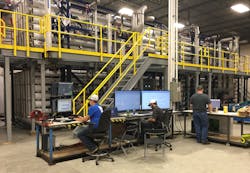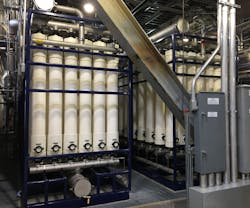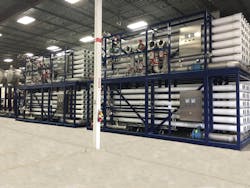Enhancing Demineralization Capacity at Con Edison’s East River Facility
Consolidated Edison Company of New York (Con Edison) provides electric, gas and steam service to 3.5 million customers in New York City and Westchester County, New York. Con Edison has five steam-generating plants in New York City that provide steam for heating residential and commercial buildings in Manhattan. The water used to generate the steam requires demineralization treatment to prevent scaling in the boilers and the steam distribution network.
Con Edison’s East River steam generating facility (East River) is alongside the East River on the East Side of Manhattan. This facility has two systems to treat feed water for the boilers that generate the steam. One is a conventional mixed bed cation and anion demineralization system and the other is a more modern system using reverse osmosis (RO) and electrodeionization (EDI).
Demineralization Processes
Total dissolved solids (TDS) consisting of ions such as calcium, magnesium, silica, aluminum and other metals can precipitate at elevated temperatures and pressures within the boilers, resulting in the formation of scale and deposits. These deposits reduce heat transfer efficiency and can cause corrosion leading to boiler tube failures. The scaling ions or TDS must therefore be reduced to very low levels well below 1 ppm to protect the boiler equipment and allow efficient operation. For high purity water treatment, the water quality target is typically expressed as conductivity, which is proportional to the TDS level but easier to measure at very low TDS levels. The target treated water conductivity for the feed to the mixed bed demineralization system at East River was 50 µS/cm.
A mixed bed demineralization system consists of a strong acid cation exchange resin for removing cations such as calcium, magnesium and sodium and a strong base anion exchange resin to remove anions such as bicarbonate, sulfate and chloride. This ion exchange treatment occurs in mixed bed vessels where the resins are combined. At some point when the resins are loaded with ions, the vessels need to be taken off-line and regenerated with mineral acid and sodium hydroxide for the cation and anion resins, respectively. The higher the feedwater TDS, the more often these vessels need to be regenerated for a given volume of ion exchange resin.
Another demineralization treatment system used by Con Edison is reverse osmosis. This method removes over 99% of the TDS followed by EDI, which is used as a polishing process to achieve the treated water conductivity target. Reverse osmosis membranes are semipermeable and reject most ions, but a small percentage of ions can still diffuse through the membranes requiring additional polishing to meet high purity treatment targets. EDI is a process used for polishing RO permeate where an electric field is applied across membranes to remove ions and polar species.
Accommodating Changing Feed Water Quality
The original mixed bed demineralization system at the East River facility was designed to handle low conductivity feed water from the Delaware/Catskill Reservoir System but in recent times the city was providing Con Edison with water with a higher TDS content from the Croton Reservoir system. The higher TDS resulted in a decreased capacity of the demineralization system because of the need for more frequent regeneration of the mixed bed demineralizers.
The initial solution was to use rental ultrafiltration (UF) and RO systems in trailers to reduce TDS/conductivity levels of the feed water to increase the capacity of the demineralization system. UF is required ahead of RO to remove particulates in the feed water that would foul the RO membranes. As many as eight trailers with UF and RO equipment were parked in the streets outside the East River facility. Due to limited space in Manhattan and high costs for rental equipment, Con Edison decided to install a permanent UF and RO system to replace the trailers. Limited space within the existing building presented some significant engineering challenges to fit in this new equipment.
A Permanent Solution
The selected location for the UF and RO equipment was on the ground level of the East River facility. The project was bid to water treatment equipment manufacturers to provide 8 million gallons per day MGD of RO permeate capacity with UF pretreatment that could fit within the very constrained basement floor area. Wigen Water Technologies was selected to provide this equipment with a custom designed solution to meet the confined space requirements. Key to fitting all the equipment in the available space was an innovative stacked RO train configuration, where two sets of 2 MGD RO trains were stacked on top of each other to provide 8 MGD capacity in a footprint where less than 4 MGD capacity would normally be possible. Included in the RO system manufacturer’s scope of supply were stairways and platforms to access the top RO trains.
The ultrafiltration trains were also designed to minimize footprint with a custom configuration of 72 modules per train arranged in 6 rows of 12. All interconnecting stainless-steel piping was included in the manufacturer’s scope of supply to reduce onsite construction and the design of this piping required precise 3D modeling by Wigen’s and Con Edison’s engineers to ensure it would fit within very tight tolerances when delivered to the site.
The equipment was delivered in phases as required for installation in the confined area. The precise modeling carried out by Con Edison and Wigen ensured the equipment could fit into the building with minimal rework required. Extensive factory testing conducted with Con Edison’s engineers and operators also ensured as smooth a start-up phase as possible. The system started up in September 2018.
After start-up, the rental trailers were kept in place as a backup for the first winter heating season and were finally removed from the streets surrounding the East River facility in spring 2019. The new UF and RO systems have provided reliable operations through two full winters, with Wigen providing local service support within an hour of the facility. Con Edison operations and the East River station have been very happy with the system performance and quality of water delivered to their mixed bed demineralization system, which is consistently well below the target conductivity of less than 50 µS/cm.
Following the successful performance of the East River facility, permanent UF and RO systems have subsequently been installed at Con Edison’s 60th Street steam generation facility. WT
About the Author: Michael Bourke is director of sales and marketing at Wigen Water Technologies. He has a degree in chemical engineering from Monash University (Melbourne, Australia) and has worked in the water industry for more than 30 years as a consultant and in process equipment piloting, design and sales in Australia and the U.S. For the past 10 years he has worked with Wigen Water Technologies, managing municipal and industrial sales and overseeing many pilot studies and full-scale applications of ultrafiltration and reverse osmosis membrane systems and ion exchange systems.


